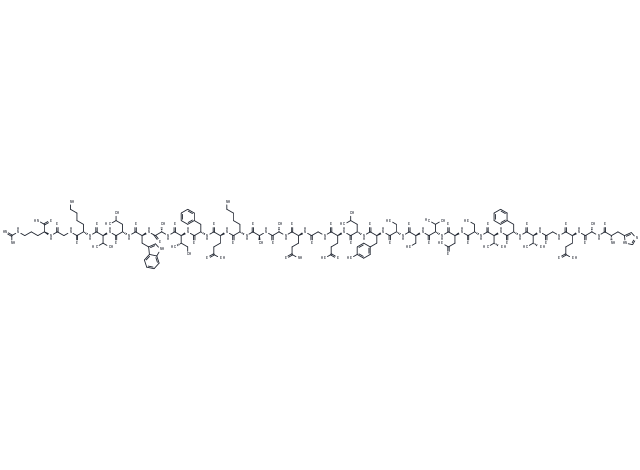keep away from moisture
Powder: -20°C for 3 years | In solvent: -80°C for 1 year

GLP-1(7-36), amide (MKC 253) is a peptide hormone released from intestinal L-cells upon nutrient consumption. It binds the GLP-1 receptor in the pancreas and displays various antidiabetic effects by potentiating glucose-induced secretion of insulin from pancreatic β-cells, increasing insulin expression.

| Pack Size | Availability | Price/USD | Quantity |
|---|---|---|---|
| 1 mg | Inquiry | $ 185.00 | |
| 2 mg | Inquiry | $ 327.00 | |
| 5 mg | Inquiry | $ 552.00 | |
| 10 mg | Inquiry | $ 793.00 | |
| 25 mg | Inquiry | $ 1,220.00 | |
| 50 mg | Inquiry | $ 1,630.00 | |
| 100 mg | Inquiry | $ 2,220.00 |


| Description | GLP-1(7-36), amide (MKC 253) is a peptide hormone released from intestinal L-cells upon nutrient consumption. It binds the GLP-1 receptor in the pancreas and displays various antidiabetic effects by potentiating glucose-induced secretion of insulin from pancreatic β-cells, increasing insulin expression. |
| In vitro | GLP-1 secretion by human enteroendocrine NCI-H716 cells is augmented in a dose-dependent manner by the addition of CPE. |
| In vivo | GLP-1 secretion is compatible with the increase in observed active GLP-1(7-36) amide levels in the portal blood after administration with CPE alone in mice. |
| Synonyms | MKC 253, Human GLP-1-(7-36)-amide, Glucagon-like Peptide 1 (7-36) amide, Glucagon-Like Peptide (GLP) I (7-36), amide, human, GLP-1(7-36), GLP-1-(7-36)-amide |
| Molecular Weight | 3297.63 |
| Formula | C149H226N40O45 |
| CAS No. | 107444-51-9 |
keep away from moisture
Powder: -20°C for 3 years | In solvent: -80°C for 1 year
DMSO: 10 mM
You can also refer to dose conversion for different animals. More
bottom
Please see Inhibitor Handling Instructions for more frequently ask questions. Topics include: how to prepare stock solutions, how to store products, and cautions on cell-based assays & animal experiments, etc.
GLP-1(7-36), amide 107444-51-9 GPCR/G Protein Glucagon Receptor MKC-253 MKC253 GCGR inhibit MKC 253 GLP 1(7 36), amide Glucagon-like Peptide 1 Amide Human GLP-1-(7-36)-amide GLP-1 GLP-1-amide Glucagon-like Peptide 1 GLP1(736), amide GLP 1 Glucagon-like Peptide 1 (7-36) amide Inhibitor Glucagon-Like Peptide (GLP) I (7-36), amide, human GLP1 GLP-1(7-36) Human GLP-1-amide GLP-1-(7-36)-amide Glucagon-Like Peptide (GLP) I , amide, human GLP-1, Amide inhibitor
